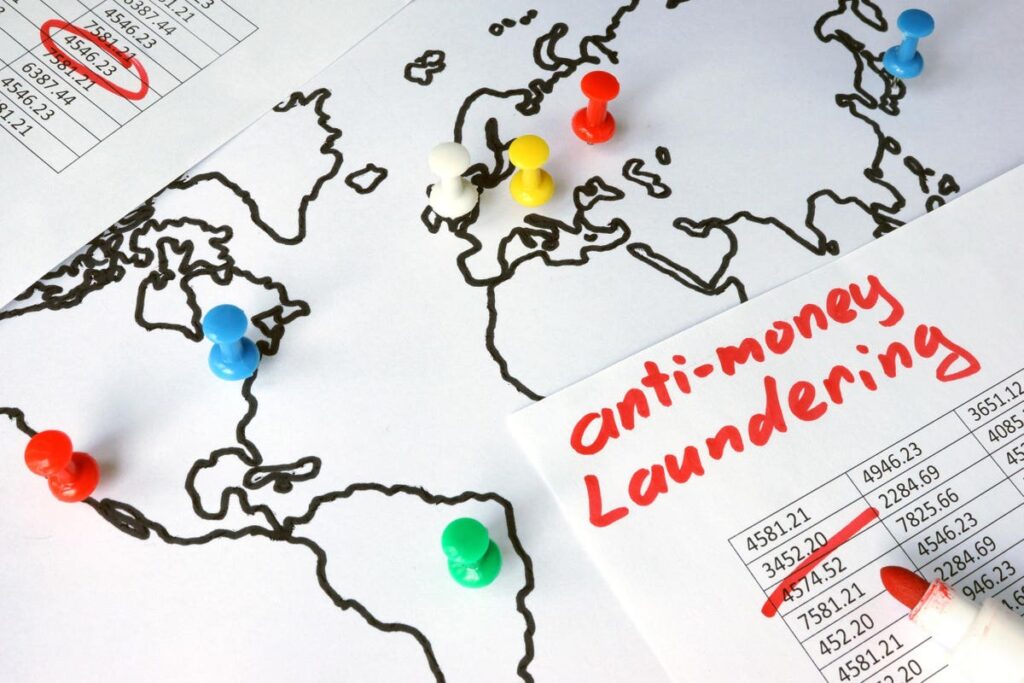In April the International Monetary Fund released a working paper explaining how tax authorities can better leverage anti-money-laundering (AML) measures to improve tax compliance and boost domestic revenue mobilization. The idea is not new, but it’s been a challenging concept for tax authorities to execute. Why? Well, tax crimes and money laundering historically have been viewed and treated as two separate issues. However, as coauthors Adrian Wardzynski and Emmanuel Mathias painstakingly describe, tax crimes and money laundering are interrelated activities that often occur in the same causal chain. Also, perpetrators of both tax crimes and money laundering offenses typically rely on similar kinds of obfuscation techniques to evade authorities. Because of this, many tools that governments use to combat money laundering can also be used to fight tax crimes. The problem is that many tax authorities are not fully aware of this approach, so they are not maximizing it the way they could.
This issue is important for countries across all income levels, according to Wardzynski and Mathias. On one hand, the current financial slowdown has prompted advanced economies to consider how they can maintain a functioning tax system without increasing tax rates, according to Wardzynski, who is counsel at the IMF. Many of them already recognized the synergies between tax and AML, but now they’re willing to take those synergies seriously, he told Tax Notes in an interview May 15.
On the other hand, this concept is also deeply important for developing countries that need to improve the efficiency of their tax systems and address endemic corruption and money laundering, Wardzynski said.
Why Are We Discussing Tax and AML?
Cross-border tax compliance initiatives have gained quite a bit of momentum in recent years. For example, the Joint Chiefs of Global Tax Enforcement (J5) was launched in 2018 as a tax-crime-fighting alliance among Australia, Canada, the Netherlands, the United Kingdom, and the United States. In emerging markets in Africa and Latin America, the OECD Global Forum is running some pilots to improve tax compliance.
The cross-border recovery of tax debts is a priority for the OECD’s Africa Initiative because few African countries are doing it. African tax administrations have the tools to enable cross-border recovery, including tax information exchange agreements and the OECD’s Convention on Mutual Administrative Assistance in Tax Matters (MAAC). However, the reality is that tax administrators have a rather limited knowledge about the cross-border recovery opportunities these instruments provide. In response, the Africa Initiative announced last year that it was developing a toolkit for countries interested in launching or strengthening cross-border tax recovery activity. At the end of March, the Global Forum conducted a new workshop on this for African countries.
In Latin America, Argentina, Costa Rica, and Paraguay have embarked on a pilot project to engage in a wider use of treaty-exchanged tax information to fight illicit financial flows and nontax financial crimes.
Increasingly, information exchange data is used to fight illicit financial flows and boost domestic revenue mobilization. Using information exchange data for nontax purposes (which the Latin America Initiative calls a “wider use of treaty-exchanged information”) is largely uncharted territory — not only in Latin America, but around the world. However, it is a key goal of the OECD’s Punta del Este Declaration Initiative, and therefore can help build important global precedents.
Like the African example, Punta del Este members largely have the domestic and international legal infrastructure to use and share tax information for AML and other purposes. The majority are MAAC signatories, which is important because the MAAC provides an international legal basis for using information exchange data for nontax purposes. Mutual legal assistance treaties, like the Inter-American Convention on Mutual Assistance in Criminal Matters (which has an optional protocol concerning tax requests), also provide another avenue.
Evolving Past the Tax Excuse
These initiatives demonstrate how some tax authorities are taking a closer look at the relationship between tax crimes and money laundering and other illicit financial flows. But exactly what is that relationship? Wardzynski and Mathias devote several pages in the working paper to the commonalities between money laundering and tax crimes. They include a common objective of concealing or disguising the source of funds, using cross-border arrangements to complicate effective domestic oversight and enforcement, and a reliance on intermediaries.
For many years, the tax community relied on the so-called tax excuse — the idea that suspicious tax-related transactions did not need to be shared with relevant AML authorities because they addressed tax matters. That thinking has since evolved to the point that the Financial Action Task Force in 2012 designated tax crimes as a predicate offense to money laundering.
Why is this important? As the working paper notes, the designation of tax crime as a predicate money laundering offense provided a legal basis for AML authorities and tax authorities to cooperate more closely. Since then, the OECD has championed that approach. In its list of 10 global principles for fighting tax crime, making tax crimes a predicate offense for money laundering is principle No. 7. In June 2022 the OECD Council encouraged all OECD countries to follow that approach in an official council recommendation.
However, it’s been over 10 years since the FATF action and it’s natural to question what may come next. Wardzynski and Mathias note that there is no internationally agreed definition of tax crime. Should there be one, for international cooperation purposes? This definition could help overcome the dual criminality issue that is customarily required in mutual legal assistance treaties. This principle requires that treaty partners criminalize the same kind of crimes or conduct as a precondition for information exchange and other forms of support.
The reality is that every country has the sovereignty to determine what constitutes a tax crime, tax evasion, or tax avoidance, Wardzynski said. Because of this, he is more concerned with how relevant authorities decide to treat specific kinds of conduct, and is less focused on formal definitions. This is the same sort of approach recommended by the FATF and the OECD.
“It certainly would be beneficial if the international community could agree on certain conduct that should be seen as egregious enough to warrant the type of international cooperation we need in this field,” Wardzynski said. “The other option is to look at it from a perspective that when there is a request for international cooperation that involves a foreign taxpayer, the definition of tax crime as applicable in that taxpayer’s country should be the leading one.”
When asked whether there are any other definitions or concepts that need some sort of international consensus for cross-border tax cooperation purposes, Wardzynski said the same emphasis on conduct should prevail.
“I think if we have more flexible thinking about this, we could avoid the nitty gritty of having the same definition. It would be very hard to find an agreement on that. Maybe within the EU to some extent, but still even there,” he said. “So the key is to focus on the conduct and have some appreciation for the fact that what we’re dealing with is foreign taxpayers. And perhaps the local understanding of what the tax crime is should not be taken very strictly [in that context].”
Currently, there is little to no international consensus on the types of misconduct that should trigger cross-border cooperation, which the working paper flags as an issue. But where might be a good forum to discuss this? The FATF or its regional bodies? The OECD’s Global Forum or its Task Force on Tax Crimes and Other Crimes?
Wardzynski said the forum that brings together as many member countries as possible would naturally be a good place. At the same time, there should also be targeted engagements where countries can join working groups to address specific issues of interest.
Even though there’s no international consensus, there are good initiatives — albeit a patchwork — being undertaken by the FATF and OECD, he said.
“Perhaps we need something more — still, we have silos,” Wardzynski said. “The key is that we have a global standard that is globally endorsed, and it’s a good standard — that’s very important. It’s not just any standard or one that’s only about having 190 members agreeing on it straightaway.” Ideally, a comprehensive standard could initially be negotiated within a targeted group of countries. That group would need to be representative of various regions and development levels, including experts from both the tax and AML fields, Wardzynski added. From there, the standard could be expanded and endorsed by everyone else.
At the domestic level, there’s a lot of room for exploration on how AML measures can strengthen tax compliance. The working paper lists 17 different AML measures that are relevant to tax compliance frameworks, in four aspects: formalization, detection, enforcement, and deterrence.
On the formalization side, transparency measures like customer due diligence identification and recordkeeping requirements and beneficial ownership registries can help tax authorities identify taxpayers and better identify potentially taxable income, assets, and businesses, according to the paper.
On the detection side, suspicious transaction and activity reports, as well as identification and analysis that financial intelligence units conduct on financial transactions, capital flows, and assets are useful in detecting tax offenses, determining a taxpayer’s risk profile, and better targeting tax audits.
On the enforcement side, legal provisions that allow for the freezing and seizure of financial accounts and assets, as well as extended statutes of limitations, can complement measures already at the disposal of authorities pursuing tax crimes.
On the deterrence side, AML measures like increased transparency on financial and business activities, civil and criminal sanctions, and confiscation of laundered assets are important from a tax perspective because they can help tax authorities recoup unpaid taxes and dissuade potential offenders, according to the working paper.
Voluntary Disclosure and Money Laundering
The relationship between tax crimes and money laundering is particularly important in the context of voluntary disclosure and tax amnesty programs. For countries seeking guidance on this, the FATF in 2012 released four basic principles on voluntary tax compliance programs.
The first principle is that countries, as a prerequisite, must effectively apply anti-money-laundering/countering the financing of terrorism (AML/CFT) preventive measures to their voluntary tax compliance programs.
The second principle is that voluntary compliance programs should not allow any full or partial exemptions from AML/CFT requirements. Any such measures explicitly breach the FATF’s recommendations.
The third principle concerns domestic cooperation. Governments, when implementing voluntary compliance programs, should ensure that domestic authorities can cooperate when money laundering abuses occur. This means they should guarantee that all domestic authorities can exchange information to coordinate and cooperate on detecting, investigating, and prosecuting money laundering abuses.
The fourth principle addresses international cooperation. When money laundering abuses occur, governments should provide the widest possible range of information exchange and mutual legal assistance in investigations, prosecutions, and related proceedings. This includes asset recovery investigations and actions.
The IMF has also published a technical note about the importance of close tax and AML cooperation, “Voluntary Disclosure Programs — Design, Principles, and Implementation Considerations.” One of the paper’s key recommendations is that all countries, when designing voluntary compliance programs, should submit their proposed programs to the FATF, or to their FATF-style regional bodies, for a review.
Despite this advice, governments don’t always link their voluntary compliance programs with AML measures, which makes Wardzynski and Mathias’s paper all the more important.
For example, in 2022 the IMF voiced concerns about a tax amnesty program contemplated by Albania. That amnesty reportedly would allow both Albanian taxpayers and foreign citizens to deposit up to €2 million of previously undeclared cash into Albanian banks. However, the suggested amnesty raised tax compliance concerns, because the money would be taxed between 5 to 10 percent, which is significantly less than the combined 32 percent rate those individuals would normally pay. The proposal also raised money laundering concerns because participants would receive full legal immunity.
Moving From Identification to Collection
Tax transparency frameworks, like the OECD’s exchange of information regime, have helped revenue authorities around the world identify or collect at least €11 billion in additional tax over the years. For developing countries, exchange of information regimes have been very helpful for identifying offshore financial accounts, but recovery presents a significant challenge and African countries are not alone in this. This led the Global Forum in 2019 to flag cross-border assistance in tax recovery as an important issue. It’s a topic that Wardzynski also believes deserves further exploration. He said that stronger links between tax and AML regimes could help bridge this identification-collection gap.
“The international AML framework could be very helpful in that respect, because it provides for broad instruments for cross-border cooperation on things like confiscation, freezing, and seizing of financial accounts and assets. If there’s greater recognition of the synergies between the two frameworks, then there’s a greater chance that the frameworks that are already available would be utilized,” Wardzynski said. “Many of the procedures we have already in place could be utilized to a greater extent.”
What Should Authorities Prioritize?
Wardzynski and Mathias’s working paper is clear that tax authorities have several options when syncing their tax and AML regimes. After all, there are at least 17 different AML measures applicable to tax compliance. This raises the question: How should authorities even start their journey? According to Wardzynski, there are a few steps they should prioritize.
The first thing is understanding the applicable legal framework and mapping out the mandate of the respective tax and AML authorities to see where they overlap, Wardzynski said.
“Then, evaluating how does the law reflect the synergies. Are these already recognized, are there avenues in place that could enable sharing of information in an efficient way? In many cases it would, but there would be missing procedural rules which would offer certainty on how a law could be applied in practice,” Wardzynski said.
From there, establishing procedural rules and memoranda of understanding are very important.
“We’re starting from a base where the two areas [tax and AML] were very suspicious of one another and may not be used to cooperating. Their understanding of the key concepts may differ, and the people working there may not have the confidence, even if the law allows for cooperation, to apply the rules in a such a way because they may fear that they overstep their mandate,” Wardzynski said.
Wardzynski said that countries’ execution of international tax transparency frameworks provide a good example of this kind of tension.
“Tax information is exchanged across borders, it might point to a tax crime or AML case, but the tax authorities might not be comfortable sharing with the AML authorities. It’s not that they cannot do it; they can because the international standard allows it,” Wardzynski said. “But in practice, sharing hardly happens. Similar issues arise in the domestic context,” he added.
The answer, Wardzynski said, is to empower those authorities with procedural rules, memoranda of understanding, liaison officers, guidance, and awareness raising.
Read the full article here













